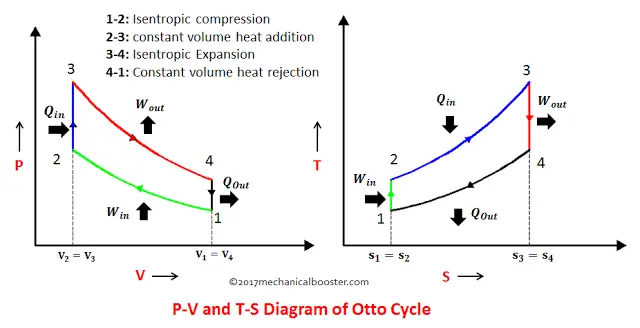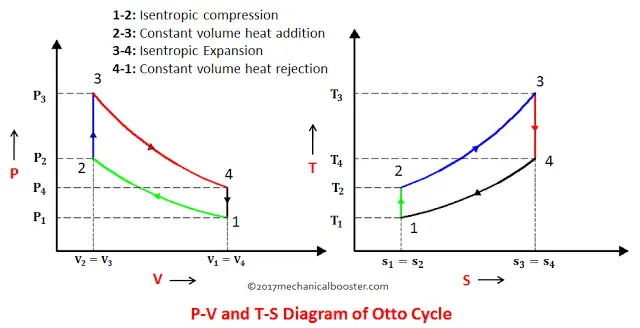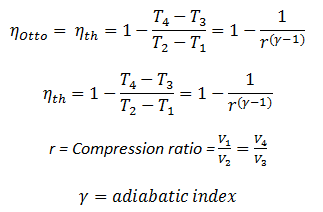Ts Diagram For Four Stroke Petrol Engine
The Otto cycle was given by Dr. Nikolaus August Otto. It is a gas power cycle that is used in spark ignition engine (i.e. petrol engine) for its working. The entire modern petrol engine works on Otto cycle. It consist of four processes, Two isentropic (reversible adiabatic) processes and two isochoric (constant volume) processes. It has low compression ratio ranges from 7:1 to 10:1. Here we will try to understand this cycle with help of its P-V and T-S diagram.
The four processes of this cycle is as follows:
1. Isentropic ( reversible adiabatic) compression
2. Constant volume (Isochoric) heat addition
3. Isentropic (reversible adiabatic) Expansion
4. Constant volume heat rejection.
Before starting to understand these four processes, lets us first understand about isentropic and isochoric process.
- Isentropic Process: It is a thermodynamic process in which the entropy of the system remains unchanged (i.e. entropy remains constant). There is no dissipation of heat takes place during isentropic process, so sometime isentropic process called as reversible adiabatic process.
- Isochoric Process: The process which takes place at constant volume is called isochoric process.
How Otto Cycle Works?
Now, with the help of P-V and T-S diagram, we can easily understand all the process of Otto cycle.


Note: For better explanation, while reading watch the P-V and T-S diagram everytime.
1. Process 1-2: Isentropic Compression
This process involves the motion of piston from TDC to BDC. The air that is sucked into cylinder during suction stroke undergoes reversible adiabatic (isentropic) compression. Since the air is compressed, the pressure increases from P1 to P2, the volume decreases from V1 to V2, temperature rises from T1 to T2, and entropy remains constant.
2. Process 2-3: Constant Volume Heat Addition
This process is an isochoric process i.e. the heat is added to the air at constant volume. The piston in this process rest for a moment at TDC and during this time heat is added to the air through external source. Due to the heat addition, the pressure increases from P2 to P3, pressure, volume remains constant(i.e. V2=V3), temperature increases from T2 to T3 and entropy increases from S2 to S3.
The amount of heat added is given by

3. Process 3-4: Isentropic Expansion
In this process, the isentropic (reversible adiabatic) expansion of air takes place. The piston moves from TDC to BDC. Power is obtained in this process which is used to do some work. Since this process involves expansion of air, so the pressure decreases from P3 to P4, volume increases from V3 to V4, temperature falls from T3 to T4 and entropy remains unchanged (i.e. S3=S4).
4. Constant Volume Heat Rejection
In this process, the piston rest for a moment at BDC and rejection of heat takes place at constant volume. The pressure decreases from P4 to P1, Volume remains constant (i.e. V4=V1), temperature falls from T4 to T1.
The amount of heat rejected in this process is given by

When this cycle is used in four stroke petrol engine than two process increases. one is suction of air fuel mixture inside the cylinder which takes place at constant atmospheric pressure and other one is exhaust of gases out of the engine cylinder at constant atmospheric pressure. These two process are not shown in ideal otto cycle that we have discussed above.
Summary in Tabular Form
| S.no | Process | Operation | Position of piston | Change in parameter |
| 1. | 1-2: Isentropic Compression | Compression of air. | BDC to TDC | V: Decreases from V1 To V2 T: Increases from T1 to T2 P: Increases from P1 to P2 S: Entropy remains constant (S1=S2) |
| 2. | 2-3: Constant Volume Heat Addition | Heat is added in the form of spark and combustion occurs. | At TDC for a moment | V: Remains constant (V2 = V3 ) T: Increases from T2 to T3 P: Increases from P2 S: Increases from S2 to S3 |
| 3. | 3-4: Isentropic Expansion | Expansion of air takes place due to heat addition. | TDC to BDC | V: Increases from V3 to V4 T: Decreases from T3 to T4 P: Decreases from P3 to P4 S: Entropy remains constant (S3=S4) |
| 4. | 4-1: Constant Volume Heat Rejection | Heat is rejected to a sink. | At BDC for a moment | V: Volume remains constant(V4 = V1 ) T: Decreases from T4 to T1 P: Decreases from P4 to P1 S: Decreases from S4 to S1 |
Thermal Efficiency
The efficiency of Otto cycle is given by

Application
It is used in all two stroke and four stroke petrol engines of motorcycles, cars, and other light duty vehicles.
If you find anything missing or incorrect than lets us know through your valuable comments. And if you found this topic informative than don,t forget to like and share it on social networks. Thanks in advance.
Source: https://www.mechanicalbooster.com/2017/10/otto-cycle.html
Posted by: ericericlanzafamee0272037.blogspot.com
Post a Comment for "Ts Diagram For Four Stroke Petrol Engine"